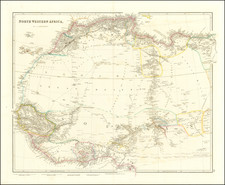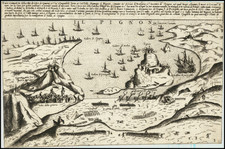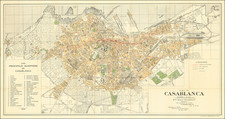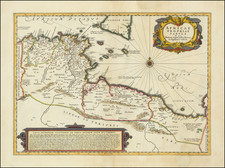Of Second Barbary War Interest
Large engraved folding map focusing on the North African states of Morocco, Fez, Algeria, Tunis, and Tripoli, at the time of the Second Barbary War. The map features detailed insets of Ceuta, Oran, Algiers, Tunis, the forts and canal of La Gouelette, and Tripoli. The map depicts the theater of the Second Barbary War during that conflict.
Second Barbary War
The Second Barbary War (1815-1816), was the second of two wars fought between the United States and the North African Barbary states of Tripoli, Tunis, and Algeria. The war between the Barbary states and the U.S. ended when "the U.S. Senate ratified Decatur's Algerian treaty on December 5, 1815". However, Dey Omar Agha, the ruler of Algeria, repudiated the US treaty, refused to accept the terms of peace that had been ratified by the Congress of Vienna, and threatened the lives of all Christian inhabitants of Algiers. William Shaler, the US commissioner who had negotiated alongside Decatur, had to flee aboard British vessels and later watched "shells and rockets fly over [his] house like hail" as a result of the subsequent Bombardment of Algiers (1816). Shaler then negotiated a new treaty after the Bombardment of Algiers in 1816, which was not ratified by the Senate until February 11, 1822, owing to an accidental oversight.
General Nicolas Charles Oudinot
A final detail that gives this map particular importance is the identity of its former owner, Nicolas Charles Oudinot, 1st Comte Oudinot, 1st Duc de Reggio (1767 - 1848), and a Marshal of France. A fierce fighter, the man was wounded no less than 34 times during his military career!
The only one of nine siblings to live past childhood, Oudinot joined the army without a noble pedigree, and therefore without a chance of high promotion. That all changed in 1792, with the outbreak of the French Revolution. In that year, Oudinot was elected lieutenant-colonel of the third battalion of the volunteers of the Meuse. After transfer to the regular army and admirable service in Belgium, he was promoted to the rank of general in June 1794 after the Battle of Kaiserslautern.
From Belgium he shifted to the German and Swiss fronts, where he fought as a general of division and chief of staff to Andre Massena. Oudinot stood out at the Battle of Monzambano so much so that Napoleon himself presented him with a sword of honor, now known as the Legion d'Honneur. Napoleon did not forget him after he established his empire; now Emperor Napoleon recognized Oudinot again, this time with a Grand Cross of the Legion of Honor.
During the Napoleonic Wars, Oudinot continued to acquit himself commendably. He was elected a member of the Chamber of Deputies, commanded a company of grenadiers nicknamed for him, and fought in battles from Vienna to Poland. In 1808, he was appointed governor of Erfurt and was made a Count of the French Empire. Finally, in 1809, after the Battle of Wagram, he was named a Marshal of France, France's highest military distinction.
Oudinot continued to serve as an administrator in Holland and on the battlefield in the Russian campaign. After Napoleon's fall, Oudinot joined the Bourbon Restoration and stayed loyal to the King even after Napoleon's return in 1815. For his loyalty and service, he was named a peer of the realm. He served until 1823, when he participated in the French invasion of Spain. Then, he turned again to political and administrative appointments; he died while serving as governor of Les Invalides, at the veterans' hospital in Paris.
Provenance
Purchased at auction in Paris, from Artcuriel, Collections from the Castle of Malicorne Marshal Oudinot's Historical Souvenirs, June 13, 2017 (Lot 156).











![[ The Honorable Kingdom of Morocco ] المملكة المغربية الشريف](https://storage.googleapis.com/raremaps/img/small/96404.jpg)

![[Capture of Mahdia in 1550] Vera urbis Africae descriptio, p Illust. D. Viceregem Sicilae, & Antonium Doriam, Caroli. v. Imper inuictiss. Duces iam expugnatae. 1550](https://storage.googleapis.com/raremaps/img/small/78592.jpg)
